2816 on the
Internet
By Rainer Auer, Roger Burrows, Gordon
Hall, Tim Horton, Roy Kelleway, R.L. Kennedy, Ray Matthews, Donald Scott, William Slim, Joe Smuin, Brian Stevenson,
Ken Storey, Dick Sutcliffe, Helmut Wisinger, and Canadian Pacific Railway of course.
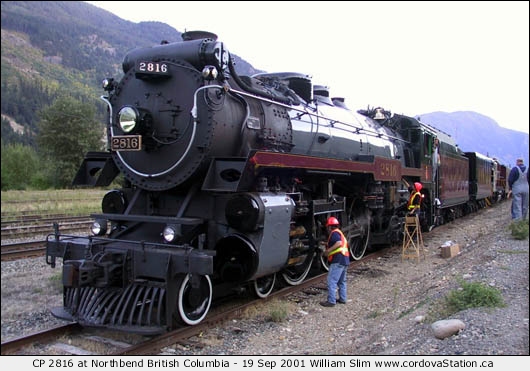
Canadian Pacific Railway number 2816, "The Empress",
was serviced at Northbend after the first day of her inaugural run from Port Coquitlam, British Columbia, to Calgary,
Alberta, on 19 Sep 2001. On the right locomotive engineer Dale McCormack walks away as helpers polish and
touch-up a few paint chips with cans of spray paint.
 The story of Canadian Pacific Railway locomotive number 2816 began in
1930 when the locomotive was constructed by the Montreal Locomotive Works. Recently CPR summarized her history as
follows: The story of Canadian Pacific Railway locomotive number 2816 began in
1930 when the locomotive was constructed by the Montreal Locomotive Works. Recently CPR summarized her history as
follows:
CPR's 2816 is a class H1b Hudson type locomotive built by Montreal Locomotive Works in December 1930. CPR Empress is
now the only surviving H1b Hudson and is one of only a handful of preserved and operating CPR steam locomotives in
North America. Today, after a complete three-year rebuild, 2816 is restored to the original specifications
with external details from the 1940s-1950s.
For railfans there's much more to the story than this brief history from CP. The article below,summarized from various
sources found on the internet paints a much broader picture of CP 2816, The Empress.
Early History
| |

CP 2816 is shown here in 1931 at Winnipeg, Manitoba - Photographer
unknown.
|
Canadian Pacific Railway's last steam-era mechanical chief, Henry Blaine bowen, took the helm in 1928.
Before the great depression set in, he ordered 51 non-streamlined steam locomotives. Out of all 51 of
these locomotives, 2816 is the only survivor. And locomotive 2816 is one of only a handful of the 48 preserved CPR
steam locomotives in North America that can operate.
CPR's 2816 is a class H1b Hudson type locomotive with a 4-6-4 wheel arrangement. CPR acquired 20
non-streamlined Hudson type locomotives in 1929 and 1930, adding 45 more semi-streamlined
4-6-4 locomotives, between 1937 and 1940. These 45 semi-streamlined class H1 locomotives
were later called Royal Hudsons after two of them were made famous with the 1939 royal visit of Their Majesties King
George VI and Queen Elizabeth.
| |

2816 with "elephant ears" location unknown - BC
Archives.
|
Montreal Locomotive Works built class H1b locomotive 2816 in December, 1930, at a cost of $116,555. It first ran with
its other "class mates" between Winnipeg and Calgary, and Winnipeg and Fort William, now called Thunder Bay,
before being displaced by the semi-streamlined Hudsons arriving in service between 1937 and 1940. It then
ran out of Toronto on the Windsor-Quebec City corridor, with some forays into Northern Ontario, and the
odd trip into the nation's capital, Ottawa.
2816's last assignment was as a Montreal-Rigaud commuter train locomotive, making its final revenue run
on 26 May 1960. 2816 was mainly a passenger locomotive, but spent a little more than half its 30-year
operating career in fast freight service. In all, 2816 logged over 2 million miles (3.36 million kilometers).
| |

2816 at Windsor Station, Montreal, in the 1960s. Note change to
running boards and number boards from last two photos - Canadian Pacific Railway.
|
CPR sold 2816 in December, 1963. And it spent the next 35 years sitting idle in Bellows Falls, Vermont, and then
Scranton, Pennsylvania, before being transferred back to Canadian Pacific Railway in 1998.
Locomotive 2816 underwent an extensive three-year overhaul, including converting the locomotive to burn
oil instead of coal, making it cleaner and easier to operate. The locomotive is restored to its 1950s appearance and
will operate again in 2001 as CPR's roving ambassador - Canadian Pacific Railway.
17 August 2000
| |
 2816 receives a repair to her drawbar pocket at CPR's Alyth diesel
shop in Calgary before continuing to North Vancouver - Canadian Pacific Railway. 2816 receives a repair to her drawbar pocket at CPR's Alyth diesel
shop in Calgary before continuing to North Vancouver - Canadian Pacific Railway.
|
Boiler - hoped for any time soon, not expected until September. Work on other parts of engine has progressed well and
is probably safe to say that about 95 percent of the other rebuild work on engine is nearing completion. Best case
scenario has engine ready to heat up in late November or early December. There was a goof on the boiler project in
Portland which meant that considerable work had to be redone. The steam shop boys tell me they have learned a lot of
interesting things from the 2816 project which will be applied to the 2860 project. One thing they discovered is that
there are still all the specs they need to have the drivers recast from scratch and there is an outfit in the States
that does that sort of thing. This is very good news indeed - Joe Smuin.
20 December 2000
With respect to the 2816, the boiler/firebox is still at Daylight Locomotive Works ( the subcontractor ) in
Portland and is now due to be returned to North Vancouver in January 2001. The work has been delayed due to a batch of
staybolts which were manufactured incorrectly. The wheels and frame have been reassembled and tested, and the tender
has been restored and painted. Completion of the overhaul is now set for Spring 2001. We'll see... - Tim
Horton.
2816 Enroute "Dead in Transit"
 2816 at Kamloops enroute to North Vancouver - Photographer
unknown. 2816 at Kamloops enroute to North Vancouver - Photographer
unknown.
|
 Location and date unknown, enroute to North Vancouver - Gordon
Hall. Location and date unknown, enroute to North Vancouver - Gordon
Hall.
|
 Location and date unknown, enroute to North Vancouver - Gordon
Hall. Location and date unknown, enroute to North Vancouver - Gordon
Hall.
|
BC Rail's Steam Shop in North Vancouver
 Disassembly commences at BC Rail Steam Shop in North Vancouver for
the assessment phase - 11 May 1999 Roger Burrows. Disassembly commences at BC Rail Steam Shop in North Vancouver for
the assessment phase - 11 May 1999 Roger Burrows.
|
 Boiler and running gear outside BC Rail Steam Shop - Photographer
unknown. Boiler and running gear outside BC Rail Steam Shop - Photographer
unknown.
|
 2816 inside the BC Rail Steam Shop during the driver removal
procedure - 18 Nov 1999 Roger Burrows. 2816 inside the BC Rail Steam Shop during the driver removal
procedure - 18 Nov 1999 Roger Burrows.
|
12 January 2001
| |
 2816's boiler returns from Portland, Oregon, on a flatcar pulled by a
Great Northern unit in heritage paint scheme - Photographer unknown 2816's boiler returns from Portland, Oregon, on a flatcar pulled by a
Great Northern unit in heritage paint scheme - Photographer unknown
|
Well its finally returned and in grand fashion! After a rather secretive move the boiler for CPR Hudson 2816 was moved
from Portland to North Vancouver on Thursday. It was shipped on a CP bulkhead flat and accompanied by Doyle McCormack's
recently rebuilt, and superbly restored, GN F7 274. Also along for the ride was GN painted PNWC 600 "Mount
Hood" and a daylight painted Willamette and Pacific baggage car. With a little help from train spotters in Oregon
I was able to intercept this train in Everett and paced it north to New Westminster, where it arrived at 20:45 last
night. A CN crew was to be called to take it the rest of the way to North Vancouver. Now the real fun begins. The 2816
will start to take shape over the next two months. Since most of the other parts have been completed they only had to
await the boiler to proceed with assembly. If all goes well a steam up could be 60 days away - Ken
Storey.
| |
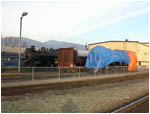 Boiler sits on flatcar between 3716 and 2860 at BC Rail Steam Shop -
16 Jan 2001 William Slim. Boiler sits on flatcar between 3716 and 2860 at BC Rail Steam Shop -
16 Jan 2001 William Slim.
|
Perhaps the most elaborate plans for mainline steam come from Canadian Pacific, which hopes to bring 2816 out of the
shop in April to begin performing as a corporate ambassador. The Hudson type ( Montreal Locomotive Works, 1930 ) has
been undergoing an extensive overhaul based at BC Rail's North Vancouver steam shop. On 3 Jan 2001
contractor Doyle McCormack, who did an extensive overhaul at his shop in Portland, Oregon, shipped the engine's boiler
converted to burn oil back to CP. Once operable, the 2816 will head up a community outreach program that CP says will
keep the engine on the road 180 days per year. The 4-6-4 might also pull some high-end
excursions with the Royal Canadian Pacific luxury passenger equipment - Unknown source.
30 January 2001
The tender, ex-1517 is now CP 35508, ( ex-DH 35508 ) and is all one compartment. It was used
for diesel oil storage. 33,000 gals = 27,500 Imperial gallons compared to 12,000 for 2816. This means 3 1/4 tanks total
capacity and will allow 2816 to run 3 Divisions without taking water. Oil would be good for about 5-6
Divisions. She won't be pulling heavy tonnage and will be restricted to 79 mph, at least officially. The 2800's were
counter-balanced for 90 mph and could top 100 slightly. The fellow in charge of the 2816 project came
across the tender in Binghamton and commandeered it. Had he been 3 weeks earlier there was ANOTHER steam engine tender
being used elsewhere for oil! It was scrapped, after all these years - R.L. Kennedy.
The tender that 4-6-4 No. 2816 carried with her toward the end of steam did indeed come from the 2822.
Contrary to a recent article by Jonathan Hanna in "CP News" wherein he says the tender swap occurred after
1955, the actual swap was made at Angus Shops between Sept. 1951 and Sept. 1952. Photos of 2822 taken on these two
dates show the different tenders clearly. Before we get a deluge of questions and speculations as to why, likely it was
as simple a matter as either 2816 or 2822 had their shopping completed, but one of their original tenders was not
finished. So the most urgently required engine was given the other's tender. Swaps like this were very rare, but they
did occur - Ray Matthews.
27 February 2001
The boiler for 2816 was lowered onto the chassis on Thursday, 21 Feb 2001 and the oil bunker was
lowered into the tender on the same day - Tim Horton.
21 March 2001
There is an estimated 45 days of work ahead before 2816 will be ready for lighting up. The boiler is back on the
frame and re-piping is well underway. Remember that the 45 day estimate must include weekends, so the
time frame will expand. I even heard guesstimates today of July before the old girl is stretching her legs. Once she
is ready for lighting up, she must undergo more tests and what happens then will determine how quick she migrates.
My guess is at least well into June before she will be ready to try moving under her own steam - Joe
Smuin.
22 April 2001
Parts are gradually reappearing on the 2816. The reverse wheel and linkage is in place, and they were working on
guides and crossheads, when I was in the shop the other day. Four or five men are doing the work that in steam days
would have been performed by perhaps more than 20 men. It is a real study to watch the painstaking efforts that have to
be taken to ensure that alignments are correct and things are square and fit just so. Small wonder the railways ditched
steam power at the first opportunity - Joe Smuin.
27 April 2001
The cab of 2816 was put in place on the engine frame Tuesday evening past. The old girl is slowly starting to look
like a steam engine again. Still lots of work ahead, though - Joe Smuin.
24 May 2001
I don't think that the delays can be attributed to faults on the part of the North Vancouver facility and staff. First,
in essence, less than six tradesmen are doing what upwards of 30 men would have done in a major backshop 60 years ago.
Second and most important, there is no handy supply of parts to slap on willy-nilly. Every little thing
that can't be quickly and easily repaired usually has to be built from scratch and it is often no small task to find
somebody with the skills and facilities to do such work. Bear in mind that a big part of the delay in Portland involved
quality control in the materials provided by a supplier. How in the world does anybody foresee or anticipate the scope
of the problems presented by that kind of a situation? I've watched a lot of work get done on the 2860 and 3716 over
the years and I've never seen any project go as quickly or smoothly as initially estimated. Given what they've got to
work with, the BC Rail steam shack boys have done one *@#*!! of a good job and without them neither the CPR or anybody
else would have a couple of genuine CPR steamers ( soon to be three ) to watch in regular action - Joe
Smuin.
6 June 2001
The 2816 cab measurements are too high above top of rail and will not clear the exhaust vents track side from the food
court in Gulf Square without major rework on them. We have had altercations with the vents with business car movements
as well. The "shed" has room for 10 cars which is our current fleet. With the Mount Royal from Montreal being
reassigned to Royal Canadian Pacific very soon we will have one car too many for the building - Brian
Stevenson.
12 June 2001
At the Spirals 3 conference last weekend CP's Jonathan Hanna, who was giving a presentation there which included the
heritage train, mentioned they hoped to start testing the 2816 between Coquitlam and Mission towards the end of July,
and if everything went satisfactorily, run her in a 3 car train to Alberta in August. He showed us some pretty
up-to-date pictures - Helmut Wisinger.
29 June 2001
Only the tender and cab are in CPR colours at this point. The boiler will not have the lagging and jacket applied
until after tests under her own steam have been completed. At least, that is the plan as matters stand right now -
Joe Smuin.
5 July 2001
My boss is also the supervisor in charge of the BC Rail steam program. He told me today that 2816 is progressing well,
but there are problems involved in manufacturing castings for the superheater. The CPR is using 1940s period alloys in
the castings and a problem is arising because today's foundries are not familiar with those alloys. It is hoped to have
2816 steaming early in August. 2816 will probably go home in September - Joe Smuin.
25 July 2001
The auxiliary tender, or "canteen car" has been at the Southern Railway of BC shops for painting. It is now
en-route to North Vancouver for mating with 2816's tender - Roger Burrows.
26 July 2001
| |
 Smoke box before new super heater tubes were added - Ken
Storey. Smoke box before new super heater tubes were added - Ken
Storey.
|
I had a phone call this evening advising that 2816 will commence her trial runs 16 Aug 2001 from Port
Coquitlam ( east of Vancouver ) east to Mission and return. Scheduled to depart eastbound to her new home in Calgary
19 Sep 2001 - Donald Scott.
8 August 2001
Observed 2816's ex-Delaware & Hudson tender ( tender off ex-D&H 1500 series
4-6-6-4 ). Beautiful enamel paint job and waxed outside Steam Shop at east end near station. Lettered
Canadian Pacific in Tuscan red, black, and gold paint scheme. 2816 in shop with tender attached, all painted in CP
Tuscan red, grey, gold, and black scheme. Some of her boiler jacket off showing piping. Smoke-box
headlight still not attached but testing ditch lights and doing radio checks with RTC ( heard on Scanner ) -
Donald Scott.
9 August 2001
The rebuilding of 2816 at the BC Rail steam shop in North Vancouver BC is almost complete. The final three superheater
bundles are expected at the shop on Thursday, 9 Aug 2001 and should be installed by the weekend. A federal
boiler inspection, under steam, is scheduled for Wednesday, 15 Aug 2001. If 2816 passes the inspection
its expected that the engine will be moved to the CPR yard in Port Coquitlam, possibly the same day. Trials and
break-in runs will commence on CP's Cascade Subdivision as early as 16 Aug 2001. The plan for
the trial runs is to operate from CP's Vancouver Intermodal Facility in Pitt Meadows to Mission and back, once or twice
per day, in a window between the morning and evening West Coast Express commuter trains. Rough times would be 08:00 to
16:00. People wishing to view the test runs and transfer moves are asked to stay off railroad property and keep back
from the steam engine to allow the crews room to do their work. If the engine fails the test for any reason, or other
problems arise, then these dates will be delayed. The engine will be missing a good deal of the boiler jacketing to
allow easy inspection of the boiler for leaks. After the trials the 2816 will return to the BC Rail steam shop for
final fitting of the boiler jacket and be prepared for a 19 Sep 2001, five day trip, from Vancouver to
CP headquarters in Calgary - Ken Storey.
11 August 2001
At 18:00 PDT, Al Broadfoot and Bill Stettler threw a lit rag into the firebox of 2816 and she was duly
"lit"! Also present were myself, Roger Burrows, and Mike Horne. She's burning diesel fuel for the first time
in her existence. As you read this, 2816 is building steam - Joe Smuin.
13 August 2001
The 2816 is testing this week. They would like people at the various crossings to enforce railfan safety. CPR will
provide helmets and vests. They need 10 to 15 people for ( probably ) Thursday to Saturday, 16 to
18 Aug 2001. They expect one trip on Thursday, a couple on Friday, and an early one Saturday. These would
be during the working day. As payment they will bus all volunteers to the BC Rail shops for a private viewing of 2816,
later in the month. Note: The testing of the engine is not public knowledge or for public release yet. ( Ha Ha )
Contact Info: Ian Libbey, Inspector Canadian Pacific Railway Police B.C., 604-927-1952, email
ian_libbey@cpr.ca. Or you can contact me, and I'll pass your availability on - Dick Sutcliffe.
14 August 2001
I was over to the shops on Monday evening. Doors were wide open and no one seemed to be around. I resisted temptation
to step inside. The superheater has been assembled and installed and the smoke box door is now in place although not
painted yet. As far as I know they have a certification test on Wednesday and if she passes will move to Coquitlam,
possibly the same day. Break-in runs could commence as early as Thursday from the VIF yard in Pitt
Meadows to Mission. Dates and times subject to change without notice of course - Ken Storey.
15 August 2001
| |
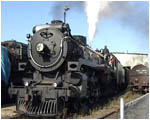 2816 is hot after more than 40 years out of service - Ken
Storey. 2816 is hot after more than 40 years out of service - Ken
Storey.
|
2816 has been steamed up. On Wednesday, 15 Aug 2001, she sat outside the BC Rail steam shop as crews
busily put finishing touches on her prior to shakedown runs starting 16 Aug 2001. Adjustments were made to
the safety valve settings, the angular number boards were mounted on the front of the smokebox ( by none other than
Doyle McCormack of SP 4449 fame ), water and oil were topped up in the tenders, and adjustments made to the feedwater
pump and a host of other items. 2816 moved under her own power on the shop track finally retreating into the shed at
20:30. On Thursday, 16 Aug 2001, a BC Rail crew has been called for 04:30 to tow the engine with a diesel
to the CP interchange from BNSF at CP Junction. From there she will steam on a mainline for the first time in over 40
years into the Coquitlam Yard to pick up her test train of grain hoppers. CP has scheduled three days of testing on 25
miles of the Cascade Sub between Coquitlam Yard and Mission beginning 16 Aug 2001 - Ken
Storey.
| |
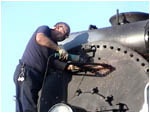
Doyle
McCormack adds number boards to smoke box front - Ken Storey.
 |
To the best of my knowledge, they have not recovered the builder's plates. The angled number board was the original
style and Al Broadfoot of the BC Rail steam shack was the push behind that. He loves the classic look. While I
understand that not everybody agreed, Al prevailed on that one! It was really something to stand in the cab of 2816
last evening watching final adjustments being made. While Ken was taking photos outside, I had the opportunity to spend
the better part of an hour with Bill Stettler while he made adjustments to the steam pressure gauges in the cab. He had
a special gauge attached to a long rubber hose which in turn mounted on top of the water glass. That gauge was used to
calibrate the other two gauges. The glass fronts came off the gauges and a weird looking little tool was used to set
the needles to the correct pressure readings. While all this was going on, Al Broadfoot, Dave Layland, and Dave Aimes
were out on the running board setting the pop valves while the engine was under steam. We blew quite a few clouds while
I was there. All three men looked ready to collapse from the heat. I also got to watch Bill blow the whistle for the
first time under steam. She has a wonderful throaty sound from a brand new whistle. The CPR truly has a new Empress -
Joe Smuin.
16 August 2001
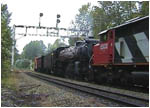 CN units tow 2816 to CPR junction - Ken
Storey. CN units tow 2816 to CPR junction - Ken
Storey.
|
|
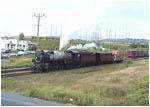 Cut-off from the CN units 2816 moves under her own power
at Fraser Mills - Ken Storey. Cut-off from the CN units 2816 moves under her own power
at Fraser Mills - Ken Storey.
|
|
 Crossing the Pitt River Bridge eastbound - Gordon
Hall. Crossing the Pitt River Bridge eastbound - Gordon
Hall.
|

Near Albion - Gordon Hall.
|
|
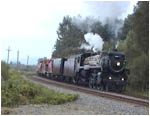 2816 approaches Mission City from the west - Ken
Storey. 2816 approaches Mission City from the west - Ken
Storey.
|
|
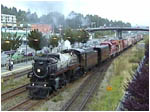 2816 departs Mission City after turning on the wye - Ken
Storey. 2816 departs Mission City after turning on the wye - Ken
Storey.
|
16 Aug 2001 was the first day for restored 2816 to operate. After being towed from the BC Rail steam
shop to a Canadian Pacific connection at Sapperton by CN diesels, the 2816 steamed off under her own power for the
first time in 40-plus years. They picked up eight empty grain cars, two cabooses, and GP38-2
number 3007 in the Port Coquitlam yard. After a lengthy wait at the Pitt River swing bridge the 2816 gained the main
line for the first day of test and break-in runs on 25 miles of CP's Cascade Sub. Several stops were made
to check for hot bearings and one problem developed surrounding lubricating oil for the valve gear. A top speed close
to 50 mph was reached east of River Road only to stop at Albion to let some bearings cool down. After that the speed
was kept to 30 mph. At Mission the train nosed south on the Mission Sub, then backed over the east leg of the wye at
Mission Junction to face west. A quicker westbound run was made with only one short check stop made at Albion. They
put the train into the Vancouver Intermodal Facility at Pitt Meadows at 15:38. Friday the crew hope to make two or
three runs to Mission - Ken Storey.
17 August 2001
| |
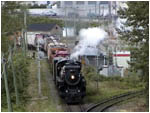 2816 reversing on the wye at Mission for last run of the day -
17 Aug 2001 Ken Storey. 2816 reversing on the wye at Mission for last run of the day -
17 Aug 2001 Ken Storey.
|
CP 2816 made two trips today between the Vancouver Intermodal Facility (VIF) and Mission. Because the train was
late arriving back on Thursday they had not turned the consist, so the first order of business was to turn on the wye
at the west end of Port Coquitlam yard. Once turned they highballed for Mission making one "pit stop" at
Albion to check things over. The lubrication problem has been solved. East of Albion they again reached maximum track
speed (for freight) of 50 mph. After a short delay to allow an eastbound CP coal train to clear the junction the 2816
was quickly turned and steamed for Coquitlam. They made no planned stops this time and only stopped for one red signal
at Ruskin and the engineer made a hasty stop at Haney after feeling a stiff jolt. The jolt was severe enough that he
actually thought some wheels had gone on the ground. He radioed to crew in the first caboose if they felt anything,
but the report was negative. I noticed that they had just crossed the switch at Northview spur. This probably was the
cause of the bump. Once an inspection was made and all wheels were still on the rails the rest of the trip was
uneventful. A second trip was made to Mission and the engine is running better and better. There is no clanking in the
rods and she is steaming really well, with the safety valves popping every time they stop. Crews are quite pleased with
the performance so far. They had time to turn the consist after the second run so they are pointing toward Mission for
Saturdays test runs. Its was not determined if they will do one, two, or three, runs on Saturday and if she will return
to the BC Rail steam shop Saturday or Sunday. A crew has been called for 07:00 Saturday for the trips. Reportedly the
steam crew is now anxious to get her back in the shop to finish the multitude of tasks to prepare for the September
trip. It is planned to have a number plate applied below the headlight. The casting for it was of such poor quality
that it was rejected. In fact they actually cast number 2716 by mistake. I do not know if it will be brass however -
Ken Storey.
18 August 2001
| |
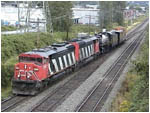 With all trials completed 2816 is shown here being towed back to the
North Vancouver Steam Shop - Ken Storey. With all trials completed 2816 is shown here being towed back to the
North Vancouver Steam Shop - Ken Storey.
|
2816 successfully completed its shakedown and test runs by making two trips to Mission today, Saturday,
18 Aug 2001. With the train already turned, the crew got an early start. At 08:10 the OK was received from
the Cascade Subdivision RTC and the 2816 charged out of the VIF yard in Pitt Meadows. With earlier lubrication problems
behind them they made no stops this time on the trip to Mission. The early morning sun made for the best lighting of
the whole test. The speed recorder in the 2816 was not working so speed was checked by radio with a crew member in the
trailing GP38-2. I hadn't noticed this on previous trips but GP38-2 3007 was not even
running. It was only along for insurance. A quick turn in Mission was made and they were on their way westbound at
09:00. After turning around in Port Coquitlam an inspection and lubrication stop was made at the Port Coquitlam West
Coast Express station. A second trip was made in much the same fashion with speeds even a little over the 50 mph
maximum for freight cars on this line. She seems to be running better and better. With a passenger train she'll be
impossible to keep up with on this stretch of track. By 13:15 the 2816 was back at the interchange with CN at Fraser
Mills. Two CN SD60F's were waiting. They "sparked up" the 3007 and after some short switching moves the CN
crew came down and picked up the 2816 and tenders plus a caboose. At 14:30 they diverged off the BNSF line at
Willingdon Junction and into the CN Thornton Tunnel on the way to BC Rail in North Vancouver - Ken Storey.
This whole business of brass number plates has been a learning experience for me. In the case of 2816, Slim's 1931
photo from the Bud Laws Collection shows it without a plate, but now I've come across a 1937 Lawrence Stuckey photo on
page 16 of "Canadian Pacific in the Rockies - Vol. 8" that shows the plate installed ( the unit had inboard
smoke deflectors at the time ). After a long search I finally found a photo of T1a 5911 with a plate installed as well.
So plates seem to have come and gone, and come again. Was it thievery or did they routinely fall off? Did the CPR cast
a quantity of plates for each locomotive at the same time, or on an as-needed basis to replace those
missing? - Rainer Auer.
In my negative collection I have photos of the following engines taken wearing brass number plates at least some of
the time during their careers:
- 4-6-4 2804, 2806, 2807, 2808, 2809, 2811, 2813, 2815, 2816, 2817, 2818, 2819
- 2-10-4 5900, 5901, 5904, 5909, 5911, 5912, 8000
- 0-8-0 6604, 6605, 6606, 6609
- 4-6-2 1201 received her's after preservation.
I'm not claiming these are the only engines of these classes to have brass number boards, only the ones I can verify
in photos. As for the wedge shaped lighted number boards, the flat faced numbers came about as a result of the Board
of Transport Commission inquiry into the disastrous head on collision at Antelope, Saskatchewan, in 1940 between
4-6-2s 2354 and 2357. ( Yes, the first semi-streamlined G3 Pacifics were built with wedge
shaped boards. ) The numbers were considered to be too small to provide positive identification at train order meets,
etc. ( CNR wedge shaped boards were considered large enough to meet the requirements. ) This order applied to any new
locomotives being built after that date, and retro-fitting of all other locomotives had to take place at
the next major shopping. This included replacing the numbers in the tear drop stack casings on 2800s, 2900s, 3000s, and
T1b class 5900s. World War II set this program back somewhat, and quite a number of smaller engines, including some
4-6-0s, 2-8-0s, and some P1 class 2-8-2s actually retained their wedge shaped
boards well into the 1950s. Hope this helps! By the way, the wedge shaped number boards and the beaver cab crest do not
properly go together on the 2816. To be correct, if the wedge shaped board is to be retained, it should have the
"Spans the World" shield. Oh well, the ditch lights on the front kind of destroy any pure attempts at
historical accuracy anyway - Ray Matthews.
19 August 2001
One dynamo is additional. Consider all the electrical gear that has been added to the locomotive in addition to the
ditch lights. First there are the radios ( 2 each ), then the radar-type speedometer system, the bearing
temperature monitoring system, the crew-alert system, and additional lighting. All consume power. And I
may have missed a few items. ( But there is no crew fridge or microwave, nor probably room for them.) Yes, the
Auxiliary Tender ( Canteen Car ) is about a foot wider than 2816's tender. As reported previously this is a former
Delaware & Hudson Challenger tender - Roger Burrows.
20 August 2001
Last week the CPR Police contacted Dick Sutcliffe and he contacted interested rail fans asking if they would like
to volunteer to watch the CPR crossings between Kennedy road in Pitt Meadows, all the way to Mission on Thursday,
Friday, and Saturday, ( 16 to 18 Aug 2001 ) while 2816 was being tested. I was a volunteer crossing guard
at the Harris Road crossing Friday and Saturday, and got LOTS of photos. Those helping got to keep their CPR issue
hard hats, protective glasses, and reflective vests, and were also given a baseball cap with the "CPR Christmas
Train" embroidered on it. Those helping will also get a tour of either the Pitt Meadows intermodal facility, or
the CP Diesel Shop, at a later date - Roy Kelleway.
19 September 2001
On 19 Sep 2001 The Empress, tested, polished, and ready to roll, departed Port Coquitlam Yard for
Calgary, Alberta. Over the next five days the journey took her through some of the best scenery in Western Canada to
be welcomed in Calgary by a huge crowd including not only the Chief Executive Officer of Canadian Pacific, Robert
Ritchie, but also the Premier of Alberta, Ralph Klein. The photos and story of those five days appeared on this web
site in October of 2001.
"The Empress" Statistics
|
Number
|
2816
|
|
Class
|
H1b
|
|
Builder
|
Montreal Locomotive
Works
|
|
Date Built
|
December 1930
|
|
Type
|
Hudson
|
|
Wheel Arrangement
|
4-6-4
|
|
Tractive Effort
|
45,300 Lbs. 20,548 Kg.
|
|
Driving Wheel Diameter
|
75 inches 190.5 Centimeters
|
|
Operating Weight
|
643,000 Lbs. 291,665 Kg.
|
|
Extreme Length
|
91 Ft. 2 in. 27.8 meters
|
|
Extreme Height
|
15 ft. 3 in. 4.6 meters
|
|
Original Cost
|
$116,555.
|
News Stories
1 Aug 2001 - Debut of an
Empress
8 Aug 2001 - Test Runs for Canadian Pacific
4-6-4 No. 2816 Postponed Until Next Week
24 Sep 2001 - Chugging History Fires
Imaginations: Cheers Greet Restored Train
3 Oct 2001 - Canadian Pacific Putting 2816 to
Bed for the Season
17 Oct 2001 - BC Rail Blows Off
Steam
15 Apr 2002 - CPR 4-6-4 No. 2816 to
Haul Vancouver Trips, Then Head for Calgary
2 May 2002 - 2816 to Port
Coquitlam
4 May 2002 - 2816 Pulls West Coast
Express
31 May 2003 - 2816 Breakfast for Learning Tour
2003 to Toronto
3 Jun 2003 - Pierre Berton to Welcome CPR Steam
Train
8 Jun 2004 - CPR Empress/GO Transit Rail
Excursion
10 Jul 2004 - 2816 Red Wing,
Minnesota
16 Aug 2004 - Steam Excursions and the Opening
of the Canadian Museum of Rail Travel
12 Jul 2005 - CP 2816
East
11 Aug 2005 - 2816 to
Calgary
1 Aug 2006 - 2816 in
Ashcroft
22 Jun 2007 - 2816 Vancouver Excursion
Schedule
28 Aug 2007 - Plenty of History in this
Ride
5 Sep 2007 - CP Makes for Historic Train
Run
10 Sep 2007 - New Old Shield on
2816
19 Sep 2007 - Steaming Out of the Past
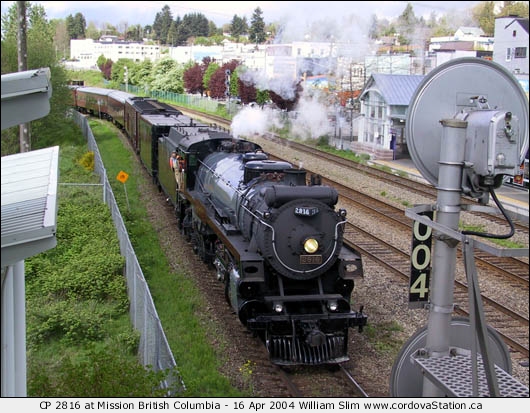
Canadian Pacific Railway number 2816, "The
Empress", approaches a signal by the West Coast Express platform at Mission City on
16 Apr 2004.

|